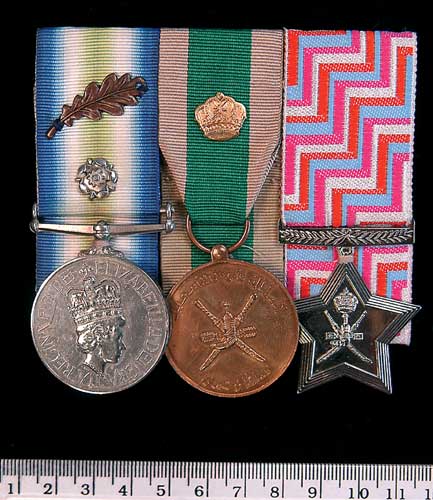
Auction: 5019 - Orders, Decorations, Campaign Medals & Militaria
Lot: 160
The Highly Emotive and Historic ´Falklands´ Group of Three to Lieutenant Commander C.J. Pollard, Royal Naval Reserve, Late Lieutenant Royal Navy, Who from H.M.S. Coventry Shot Down The Leading Aircraft from a Wave of Argentinian Skyhawks Engaged in a Low Level Bombing Attack on Coventry and Broadsword and Before Coventry was Sunk by Further Determined Enemy Air Attack South Atlantic 1982, M.I.D. Oak Leaf (Lt C J Pollard RN HMS Coventry), with rosette; Oman, Peace Medal and Operational Award; Oman, 25th National Day Medal, minor edge bruising, otherwise good very fine or better, mounted court style as originally worn, with copies of newspaper articles relating to the sinking of the Coventry, containing interviews from the recipient, and copies of letters written to his family (3) Estimate £ 3,500-4,000M.I.D. London Gazette 8.10.1982 Lieutenant Christopher James Pollard Royal Navy Lieutenant Commander Christopher Pollard, born in Leeds 1955; entered Royal Naval College Dartmouth 1973; Midshipman under training Royal Navy 1973-74; served two tours in Northern Ireland on Gun Running Patrols, 1974; appointed Master Gunner H.M.S. Eskimo 1975; stationed at Belize during Guatemalan Confrontation January-March 1976; part of escort to Queen Elizabeth II to America for Bi-Centennial visit, June-July 1976; served as "Contract Officer" Sultan of Oman´s Navy 1978-79, during which time he served on gunboats for two patrols in Dhofar Province; re-joined Royal Navy 1981; served during the Falklands campaign as Missile and Gun Direction Officer, H.M.S. Coventry (M.I.D.); after the sinking of the Coventry, posted Lieutenant H.M.S. Nottingham; joined Sultan of Oman´s Royal Yacht Squadron, 1991, where he served in the Royal Yacht, and the Royal Support Ship and also acted as Operations Officer at Headquarters; Operations Officer 1991-92 Lieutenant Commander Royal Naval Reserve. The Sinking of H.M.S. Coventry On the 25th May 1982, H.M.S. Coventry (a Type 42 Destroyer) was deployed with H.M.S. Broadsword to protect troopships landing men and equipment on the Falkland beaches. Ten miles off the coast, the two ships were attacked by a wave of Argentininian Skyhawks. The Coventry´s radar system struggled to cope with the rapid and low trajectory of the aircrafts´ approach. Pollard, who was on watch in the Ship´s Operations room used a computer link with the Broadsword, which had a better radar system. He put this to good affect, shooting down two of the advancing planes, "On both occasions I managed to pick off the leading planes, which I later realised must have been the attack leaders, and the rest of them cleared off. Looking back, that´s why they came back - this time for us. They knew they had to knock us out." Pollard went off duty at 4pm, only for the general alarm to be raised again at 6pm as the third wave of Skyhawks came at them. "It was as if everything was in slow motion. I remember seeing the British insignia on the bombs as they were released, because they were British - made. As the planes went overhead I shouted to sailors to get down. Then, through my clenched eyes, everything went white as the first of the bombs exploded. The deck heaved as the ship was lifted out of the water, it felt like my knee sockets were getting ripped out. There was smoke coming off the port side as I looked over. Then, between the main mast and the funnel, the ship just exploded. One of the bombs must have been delayed and it blew the guts out of the ship." Pollard swam to a life-raft, dragging with him what he thought to be a wounded shipmate. However, upon reaching the raft he discovered that the Laundry Boy was already dead. Hanging on to the side of the already crammed life-raft he awaited the arrival of a life-boat from H.M.S. Broadsword. As the two boats collided he received a blow to the head, and was taken dazed to the Broadsword. He later reflected, "I didn´t feel the euphoria at the time when we won the war......I still have nightmares about Garcia, one of the pilots I shot down. I later found out that his body was washed up on a beach still in his life raft two years after the war. At four o´clock that day when I shot those planes down it was the most exhilarating experience I have had. But only hours later, as I watched the Coventry go down, that was the worst moment of my life." (Letters and articles included in the lot refer) Of Coventry´s original crew of 280, 19 were killed and 25 injured that day, as she was sunk off Pebble Island.
Sold for
£7,500




